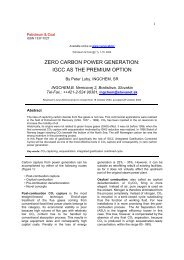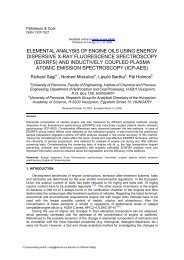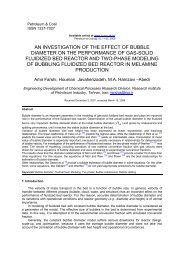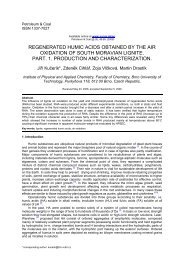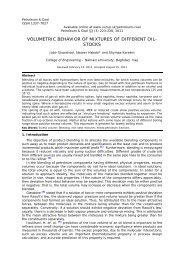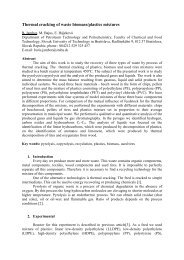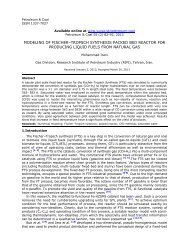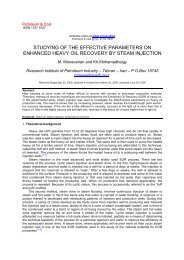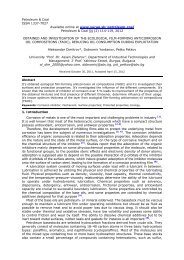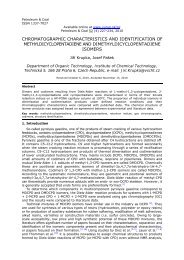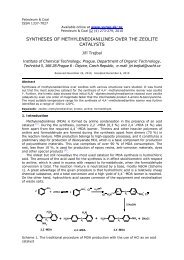separation and identification of isomeric hydrocarbons by capillary ...
separation and identification of isomeric hydrocarbons by capillary ...
separation and identification of isomeric hydrocarbons by capillary ...
Create successful ePaper yourself
Turn your PDF publications into a flip-book with our unique Google optimized e-Paper software.
5isomers also eluate in the same direction the conditions fortheir <strong>separation</strong> on mesogenic phase are easier than onthe nonmesogenic phases. The exceptional is α-value forthe pair trans-5-/trans-6-dodecenes when isomer withposition <strong>of</strong> functional group more to the centre <strong>of</strong> molecularchain exhibits higher retention as an isomer with functionalgroup more to the end <strong>of</strong> molecular chain. This result isconnected with the effect <strong>of</strong> alternation <strong>of</strong> retention <strong>of</strong>n-alkene homologues <strong>and</strong> positional isomers on the liquidcrystalline phase (Fig. 3 <strong>and</strong> 4). The retention <strong>of</strong> transisomerswith an even position <strong>of</strong> the double bond <strong>and</strong> cisisomersn-dodecenes with an odd position <strong>of</strong> the doublebond is increased, because their molecular chain is moreoriented in the direction <strong>of</strong> the molecular axis <strong>of</strong> isomers. Itcauses more drawn-out shape <strong>of</strong> molecule <strong>and</strong> thereforealso increasing <strong>of</strong> retention on the liquid crystalline phase.It reflects in reversed retention order <strong>of</strong> trans-5- <strong>and</strong> trans-6-dodecenes <strong>and</strong> in increase <strong>of</strong> the retention difference <strong>of</strong>cis-5- <strong>and</strong> cis-6-dodecenes. The possibility <strong>of</strong> the <strong>separation</strong><strong>of</strong> positional isomers with functional group in the middle<strong>of</strong> the carbon chain <strong>of</strong> molecule with new structural trait,which are the most difficult separable positional isomers onthe nonmesogenic phases, is the unique <strong>separation</strong> characteristic<strong>of</strong> the liquid crystalline stationary phases in <strong>capillary</strong>gas chromatography.Fig. 3.Dependence <strong>of</strong> selectivity factors <strong>of</strong> C 11 -C 13 positional n-alkene isomers on number <strong>of</strong> carbon atoms forliquid crystal OBO <strong>and</strong> squalane as stationary phases.
6Fig. 4.Changes in retention <strong>of</strong> <strong>isomeric</strong> trans <strong>and</strong> cis dodecenes with change <strong>of</strong> the position <strong>of</strong> double bond on aliquid crystal MAEB as stationary phase.The alternation effect <strong>of</strong> retention was observed onliquid crystalline phases for all types <strong>of</strong> <strong>hydrocarbons</strong> studied.For example in n-alkynes, 1-alkynes with an odd number<strong>of</strong> carbon atoms, 3-alkynes with an odd number <strong>of</strong>carbon atoms, etc. exhibit an increased retention [13] . Inalkylbenzenes, the n-alkylbenzenes with an odd number <strong>of</strong>carbon atoms in the molecule <strong>and</strong> those dialkylbenzeneshaving an odd number <strong>of</strong> carbon atoms in the main(longer) chain exhibit an increased retention [14] .3.2. Cis-trans isomersOn nonpolar squalane phase obtained retention dataallow the characterization <strong>of</strong> cis-trans n-alkenes retention.In Fig. 5 the retention behaviour <strong>of</strong> corresponding pairs <strong>of</strong>C 6 -C 13 cis- <strong>and</strong> trans-n-alkenes with double bond in position2- to 6- on squalane at 100 °C is presented. It is evidentthat the statement that trans-isomer elutes before thecorresponding cis-isomer is valid only for alkenes up to C 9 .In <strong>isomeric</strong> 2-alkenes, the trans-isomers are eluted first.However, the 3-isomers change the retention sequencegradually when the carbons atom number in the moleculeis increased, with lower alkenes trans-3-alkenes, <strong>and</strong> withhigher alkenes the cis-3 -alkenes, are eluted first. Thechange in the retention sequence <strong>of</strong> the 4-isomers graduallyincreases faster than that <strong>of</strong> 3-isomers. With moreinternal isomers e.g. double bond in positions 5-, 6- <strong>and</strong> 7-,the cis-isomer is eluted first.
7Fig. 5.Separation <strong>of</strong> cis/trans- corresponding C 6 -C 13 n-alkene isomers as a function <strong>of</strong> the position <strong>of</strong> double bond<strong>and</strong> the number <strong>of</strong> carbon atoms on squalane at 100 °C.Since the retention order <strong>of</strong> corresponding cis- <strong>and</strong>trans- alkene isomers on nonmesogenic phases is generallydifferent [15-17] their <strong>separation</strong> on mesogenic phase canbe better or worse than on nonmesogenic phase. Separatingcis-/trans- alkene isomers the selectivity <strong>of</strong> the liquidcrystalline phase is higher for trans- as for correspondingcis-isomers, in accordance with more stretched shape <strong>of</strong>their molecules [11] . On the liquid crystalline MEAB phaseall trans-n-dodecenes have higher retention than the correspondingcis-alkenes. From the comparison <strong>of</strong> retentionindices differences ∆(δI) <strong>of</strong> cis-trans n-dodecenes isomerson MEAB <strong>and</strong> squalane ∆(δI) in Table 2 the increasedretention <strong>of</strong> trans-n-dodecene isomers with an even position<strong>of</strong> the double bond <strong>and</strong> also the effect <strong>of</strong> isomers retentionalternation is obvious [8] . For the optimization <strong>of</strong> the<strong>separation</strong> <strong>of</strong> cis-/trans-isomers on liquid crystalline phasetheir different temperature dependence <strong>of</strong> retention can beused. On all studied stationary phases the temperaturecoefficients <strong>of</strong> retention for straight as well as branchedalkene cis-isomers are higher than for the correspondingtrans-isomers. On MEAB the differences <strong>of</strong> dI/dT cisisomers- trans-isomers ≈ 0.2 i.u./°C, are substantiallyhigher as on nonpolar phase squalane ≈ 0.03 i.u./°C.
8Table 2Differences in retention indices δI <strong>of</strong> cis-trans isomers <strong>of</strong> n-dodecenes on MEAB <strong>and</strong> squalane at 87 °CCis-trans isomers δI ∆(δI)MEABSqualanetrans-2-/cis-2- 8.5 -4.2 12.7trans-3-/cis-3- 8.9 0.9 8.0trans-4-/cis-4- 22.2 1.4 20.8trans-5-/cis-5- 19.0 5.2 13.8trans-6-/cis-6- 28.2 4.9 23.33.3. DiastereoisomersFrom comparison <strong>of</strong> the retentions <strong>of</strong> most difficultseparable C 8 -C 10 diastereomerie alkanes on mesogenic<strong>and</strong> nonmesogenic phases in Table 3 it is evident thatliquid crystalline phases (PBO, PBHP) can be more advantageousthan nonmesogenic phases also in the <strong>separation</strong><strong>of</strong> the hydrocarbon diastereoisomers [18] . The problem <strong>of</strong><strong>separation</strong> <strong>of</strong> relatively lower-boiling diastereoisomers3,4-dimethylhexane with low retention factor on mesogenicphase was solved <strong>by</strong> using a column with smaller innerdiameter (decreasing the phase ratio β) 112 m x 110 µm(Fig. 6) [19] . Generally, the better <strong>separation</strong> <strong>of</strong> diastereoisomerson a liquid crystalline phase could be obtained ifthe isomer with the more elongated molecular structurehas nearly the same retention as the other on a nonmesogenicstationary phase.Table 3Difference in retention indices δI for diastereomeric C 8 -C 10 alkanes on the different stationary phases at 40°CDiastereomericδIalkane Squalane Ucon LB SE-30 PBO PrBHP3,4-Dimethylhexane 0.0 0.0 0.3 0.0 0.93,5-Dimethylheptane 0.0 0.0 1.1 1.5 3.33,6-Dimethyloctane 0.0 0.0 0.8 1.1 2.4
9Fig. 6.Separation <strong>of</strong> diastereo<strong>isomeric</strong> 3,4-dimethylhexane <strong>and</strong> 3,5-dimethylheptane in column 112 m x 0.11 mmcoated with liquid crystal PrBHP, 40°C.3.4. EnantiomersThe combination <strong>of</strong> a very high column efficiency inrecycle <strong>capillary</strong> gas chromatography <strong>and</strong> at least lowchiral selectivity <strong>of</strong> stationary phase has been suggested tosolve the problem <strong>of</strong> difficult separable enantiomers, resp.stereoisomers [20] . The new arrangement <strong>of</strong> recycle <strong>capillary</strong>gas chromatography has been proposed replacing therecycle valve <strong>by</strong> a peristaltic pump. Possibilities <strong>of</strong> thissystems have been demonstrated on the <strong>separation</strong><strong>of</strong> 3,4-dimethylhexane stereoisomers. This hydrocarbonconsist <strong>of</strong> a pair <strong>of</strong> diastereoisomers (1:1), where one diastereoisomeris a racemic mixture <strong>of</strong> enantiomers <strong>and</strong> theother one is an achiral mes<strong>of</strong>orm. Their gas chromatographic<strong>separation</strong> on an achiral stationary phase <strong>and</strong> achiral stationary phase give two peaks with a quantitativeratio 1:1 <strong>and</strong> three peaks with 1:1:2 ratio, respectively(Fig. 7). The selectivity factor for 3,4-dimethylhexanediastereoisomers on OV-1 at 30 °C α = 1.006, for comparisonon liquid crystalline phase 4-n-pentyl-benzoic acid4’,5-n-hexylpyrimidine-2-ylphenyl ester (PBHP) α = 1.049.The selectivity factor for 3,4-dimethylhexane enantiomerson Chirasil-β-Dex (30% w,w in OV-1701) at 50 °C isα = 1.08 <strong>and</strong> for the second enantiomer <strong>and</strong> meso formα = 1.009. The applied efficiencies <strong>of</strong> recycle <strong>capillary</strong> GCwere up to 2 million plates.
10Fig. 7.Separation <strong>of</strong> stereoisomers 3,4-dimethylhexane in: (a) 50 m x 0.32 mm x 0.2 µm OV-1, 30 °C; (b) 50 m x0.25 mm x 0.2 µm Chirasil-β-DEX, 30 % selector, 50 °C; 1,2-enantiomers, 3-meso form.3.5. Complex mixturesThe priority <strong>of</strong> <strong>separation</strong> systems hyphenating thehigh efficiency <strong>of</strong> <strong>capillary</strong> columns with high <strong>isomeric</strong> selectivity<strong>of</strong> liquid crystalline stationary phases for the <strong>separation</strong><strong>of</strong> complex mixture <strong>of</strong> congeners is documented onthe <strong>separation</strong> <strong>of</strong> the process OLEX products (all <strong>isomeric</strong>C 10 -C 13 n-alkenes <strong>and</strong> n-alkanes) in comparison with the<strong>separation</strong> on column <strong>of</strong> similar efficiency coated withnonmesogenic siloxane stationary phase (Fig. 8) [8] . Inagreement with previous discussion, the retention range <strong>of</strong><strong>isomeric</strong> n-alkenes on liquid crystalline phases, defined asthe difference between the highest <strong>and</strong> the lowest retentionindex <strong>of</strong> isomers, is substantially greater (Table 4). It createsthe better conditions for <strong>separation</strong> <strong>of</strong> complex mixture<strong>of</strong> C 10 -C 13 n-alkene congeners in comparison to nonmesogenicstationary phases.
11Fig. 8.Separation <strong>of</strong> OLEX product, C 10 -C 13 n-alkenes <strong>and</strong> n-alkanes, obtained in: (a) 100 m x 0.25 mm columncoated with silicone oil DC-550, 110 °C; (b) 90 m x 0.25 mm column with MEAB at 80 °C.Table 4Ranges <strong>of</strong> retention indices <strong>of</strong> n-decenes on different stationary phases at 50 o CStationary phaseRetention interval, IδISqualane 979.2 – 999.2 20.0Apiezon 983.0 – 1005.7 22.77,8-Benzoquinoline 998.0 – 1028.0 30.0Di-n-butyl tetrachlorophthalate 998.0 - 1029.8 31.8Polyethylene glycol 4000 1035.7 – 1068.9 33.24-Methoxy-4’-ethoxyazoxybenzene at 70 0 C 973.3 – 1030.0 56.7The obtained results demonstrate the importance <strong>of</strong> liquidcrystalline stationary phases in <strong>capillary</strong> gas chromatographyfor <strong>separation</strong> <strong>of</strong> all types <strong>of</strong> <strong>isomeric</strong> <strong>hydrocarbons</strong>. Inthe case <strong>of</strong> multicomponent mixtures <strong>of</strong> different hydrocarbontypes, the <strong>separation</strong> <strong>of</strong> analysed mixtures in highefficient <strong>capillary</strong> column with nonpolar stationary phasefollowed <strong>by</strong> cry<strong>of</strong>ocusing <strong>and</strong> injection <strong>of</strong> nonseparatedpeaks in to the second <strong>capillary</strong> column coated with <strong>isomeric</strong>selective (<strong>and</strong> middle polar) liquid crystalline i.e.phase <strong>by</strong> using multidimensional <strong>capillary</strong> GC [21] can bethe most efficient tool for their <strong>separation</strong>.
124. IdentificationThe <strong>identification</strong> <strong>of</strong> <strong>isomeric</strong> <strong>hydrocarbons</strong> is usuallya most difficult stage <strong>of</strong> gas chromatographic analysis. Theproblems in <strong>identification</strong> <strong>of</strong> gas chromatographic separated<strong>hydrocarbons</strong> are connected with the lack <strong>of</strong> referencematerials, the lack <strong>of</strong> published retention data as wellas their insufficient reproducibility, further more with insufficientprecision <strong>of</strong> the structure-retention relationships, resp.retention calculation methods, <strong>and</strong> with the limitations <strong>of</strong>hyphenated chromatographic-spectrometric techniques(GC-MSD-FTIRD) as the means for the <strong>isomeric</strong> <strong>hydrocarbons</strong><strong>identification</strong> as well.4.1 Retention dataThe logarithmic retention index (Kováts retention index),I, is recommended for the <strong>identification</strong> <strong>of</strong> analytes onthe base <strong>of</strong> retention data [22] . In gas chromatography it ispossible to achieve high precision <strong>of</strong> retention indicesmeasurement, which is characterized <strong>by</strong> st<strong>and</strong>ard deviationabout 0.01 i.u. However, the interlaboratory reproducibility<strong>of</strong> retention indices is substantially lower. For examplein Sadtler’s library [23] <strong>of</strong> retention indices obtained underst<strong>and</strong>ard conditions, the reproducibility <strong>of</strong> retention indices<strong>of</strong> analytes measured on the polar stationary phase Carbowax20M not better than 2 i.u. is declared. By our opinion,this result can also be explained with differences ininner diameter <strong>of</strong> capillaries <strong>and</strong> corresponding differencesin prepared film thickness <strong>of</strong> liquid stationary phase due toassertion <strong>of</strong> the solute interface adsorption.4.1.1 Interface adsorptionOne <strong>of</strong> the reasons <strong>of</strong> poorer reproducibility <strong>of</strong> hydrocarbonretention indices is the fact that in the gas-liquidchromatography besides absorption also adsorption <strong>of</strong>analytes on the interface surface <strong>of</strong> stationary liquid phasewith carrier gas <strong>and</strong> inner wall <strong>of</strong> <strong>capillary</strong> colunm is acting[24] . In this case the relative retention data in form <strong>of</strong> relativeretentions, r is , <strong>and</strong> retention indices, are dependent on theamount <strong>of</strong> stationary phase in the column <strong>and</strong> the properties<strong>of</strong> the inner wall <strong>of</strong> column. For <strong>separation</strong> systems inwhich the <strong>hydrocarbons</strong> are analyzed on polar stationaryphases the adsorption interactions <strong>of</strong> the analytes at thepolar liquid phase - gas phase interface are characteristic.In Table 5 the values <strong>of</strong> relative retention <strong>of</strong> alkylbenzenesare given, measured on two <strong>capillary</strong> columns withdifferent film thickness <strong>of</strong> Carbowax 20M [2] . By diminishingthe film thickness <strong>of</strong> stationary phase the relative retention<strong>of</strong> alkylbenzene pairs may increase or decrease. At thinnerfilm phase the relative contribution <strong>of</strong> adsorption on surfaceinterface polar stationary phase - gas phase to analyteretention is larger <strong>and</strong> this effect is inverse proportional topolarity <strong>of</strong> an alkylbenzene. Therefore, when an alkylbenzenecongener with higher carbon atoms (less polar congener)has a higher retention than a reference alkylbenzeneon column with thicker film stationary phase, on columnwith thinner film the relative retention is higher, <strong>and</strong>vice versa. In the case <strong>of</strong> alkylbenzene isomers with decreasing<strong>of</strong> film liquid thickness, the relative retention issimilar but not equal because <strong>of</strong> different isomers polarity.Table 5The values <strong>of</strong> relative retention r is <strong>of</strong> C 15 -C 16 alkylbenzenes in two Carbowax 20M <strong>capillary</strong> columns with different filmCW − 1 CW − 2thickness <strong>of</strong> Carbowax 20M as stationary phases ( df < df )Pair <strong>of</strong> alkylbenzenesNumber <strong>of</strong> CatomsCWr is− 1 CW −r 2is1-ethyl-2-heptyl-/1-propyl-2-hexylbenzene C 15 /C 15 1.225 ≈ 1.2271-pentyl-2-pentyl/n-nonylbenzen C 16 /C 15 1.043 > 1.0221-methyl-2-octyl/1-pentyl-2-pentylbenzen C 15 /C 16 1.015 < 1.0371-propyl-2-heptyl-/1-butyl-2-hexylbenzen C 16 /C 16 1.055 ≈ 1.056
13The effect <strong>of</strong> different adsorption <strong>of</strong> hydrocarbon isomerson the surface interface polar stationary phase - gasphase is documented on Fig. 9 [7, 25] . The mixture <strong>of</strong>n-pentadecene isomers was separated under the sameexperimental conditions in two <strong>capillary</strong> columns coatedwith different film thickness <strong>of</strong> Carbowax 20M. The values<strong>of</strong> the retention factor k characterizing the film thickness <strong>of</strong>the stationary phase are 2.1 for cis-5-pentadecene in columnA <strong>and</strong> 1.3 in column B. It can be seen that the retentionorder <strong>of</strong> trans-6- <strong>and</strong> cis-5-pentadecenes on thesecolumns is reversed. This result can be explained <strong>by</strong> relativehigher contribution <strong>of</strong> trans-isomer adsorption to theretention in column with thinner film stationary phase,because trans-isomer is less polar in comparison tocis-isomer.Fig. 9.Separation <strong>of</strong> trans-7-(t-7), trans-6-(t-6), cis-5-pentadecene (c-5) at 95 °C <strong>and</strong> 0.3 MPa H 2 in two <strong>capillary</strong>columns (300 m x 0.25 mm) coated with different film thickness <strong>of</strong> Carbowax 20M, the retention factors for1-pentadecene in these columns are 1.36 <strong>and</strong> 2.25, respectively.Similarly, the value <strong>of</strong> hydrocarbon retention indexwith decreasing film thickness <strong>of</strong> stationary phase canincrease or decrease. Fig. 10 shows the dependence <strong>of</strong>the retention indices <strong>of</strong> o-xylene <strong>and</strong> 1-nonyne on the filmthickness <strong>of</strong> apolar squalane phase at 70°C in eight glass<strong>capillary</strong> columns using capillaries with the wall surfaceroughened <strong>by</strong> etching with gasesous hydrogen chlorid <strong>and</strong>deactivated <strong>by</strong> silanization in the gaseous phase withhexamethyldisilazane-trimethylchlorsilane (5:1) beforecoating [13] . It can be seen that on such columns the retentionindices <strong>of</strong> both these analytes increase as the phasefilm thickness decreases. Higher retention indices <strong>of</strong> analytesmeasured on columns with thinner film <strong>of</strong> stationaryphase result from relatively higher contribution <strong>of</strong> adsorp-
14tion to the retention <strong>of</strong> polarer hydrocarbon analytes (oxylene,1-nonyne) on interface liquid phase-wall <strong>of</strong> <strong>capillary</strong>column in comparison with n-alkanes as reference st<strong>and</strong>ardsin the retention index system. In the columns witha squalane film thicker than 0.2 µm the retention indices <strong>of</strong>o-xylene <strong>and</strong> 1-nonyne are virtually independent on thephase film thickness.Fig. 10.Dependence <strong>of</strong> the retention indices <strong>of</strong> o-xylene (1) <strong>and</strong> 1-nonyne (2) at 70 °C on the film thickness <strong>of</strong>squalane for eight glass <strong>capillary</strong> columns roughened with gaseous hydrogen chloride.On Fig. 11 the dependence <strong>of</strong> the retention index <strong>of</strong>o-xylene on the retention factor k is given obtained <strong>by</strong>measurement in ten metal <strong>capillary</strong> columns with differentfilm thickness <strong>of</strong> 1,2,3-tris-cyanoethoxypropane (TCEP) aspolar stationary phase [26] . In this case the retention index<strong>of</strong> o-xylene decreases as the film thickness decreases.Lower retention index <strong>of</strong> o-xylene measured for columnswith thinner film phase results from relatively higher contribution<strong>of</strong> adsorption to the retention <strong>of</strong> n-alkanes as comparingst<strong>and</strong>ards on surface interface polar stationaryphase - gas phase. This assumption confirms result that <strong>by</strong>the change <strong>of</strong> n-alkanes for n-alkylbenzenes as referencest<strong>and</strong>ards the previous obtained dependence is practicallyeliminated. Not complete elimination <strong>of</strong> this dependence isin connection with different polarities <strong>of</strong> o-xylene <strong>and</strong>n-alkylbenzenes; corresponding n-alkylbenzenes are lesspolar <strong>and</strong> therefore relative more adsorbed in column withthinner polar phase film. From Fig. 11 can be seen that thedifference <strong>of</strong> retention indices <strong>of</strong> o-xylene measured incolumns with thinnest <strong>and</strong> thickest film <strong>of</strong> TCEP is about200 i.u., representing approximately one thirds <strong>of</strong> fullRohrschneider-McReynolds polarity scale for aromatic<strong>hydrocarbons</strong>.
15Fig. 11.Dependence <strong>of</strong> the retention index <strong>of</strong> o-xylene (n-alkanes or n-alkylbenzenes as reference st<strong>and</strong>ards) onretention factor or its reciprocal (1/k), obtained <strong>by</strong> measurement at 50 °C in ten metal <strong>capillary</strong> columnscoated with TCEP.The stationary phase film thickness in column can bechanged in connection with evaporation <strong>of</strong> the stationaryphase from the column during its using. Because the stationaryphase evaporates preferentially from the beginning<strong>of</strong> column, the ratio <strong>of</strong> absorption <strong>and</strong> adsorption contributionsto the retention <strong>of</strong> analytes is changed <strong>and</strong> also theirretention index as a consequence [27] . Due to this fact thedependences I = f(d f ) <strong>of</strong> retention index <strong>of</strong> benzene on filmthickness <strong>of</strong> TCEP for fresh columns <strong>and</strong> for the conditionedcolumn are different (Fig. 12). At values k < 2, <strong>by</strong>conditioning column due to evaporation <strong>of</strong> stationary phasefrom the beginning <strong>of</strong> the column also the absolute contribution<strong>of</strong> adsorption to retention is changed. In this casethe retention equation derived for absorption-adsorptionmechanism <strong>of</strong> retention is not valid, because the absoluteadsorption contribution to the retention <strong>of</strong> analyte ischanged with the change <strong>of</strong> film thickness <strong>of</strong> stationaryphase.
16Fig. 12.Change <strong>of</strong> the retention index in dependence on the film thickness <strong>of</strong> stationary phase <strong>and</strong> on the retentionfactor for benzene in TCEP columns at 50 °C. 1. Dependence I = f(k) for ten fresh prepared columns withdifferent film thickness <strong>of</strong> stationary phase. 2. Dependence I = f(k) for one column during its conditioning(550 h at 140 °C <strong>and</strong> 0.2 MPa N 2 ).These results underline the problem <strong>of</strong> reproducibility<strong>of</strong> retention data <strong>and</strong> their use for <strong>identification</strong>. The reproducibleretention indices <strong>of</strong> <strong>hydrocarbons</strong> can be obtained<strong>by</strong> using <strong>separation</strong> systems in which the contribution <strong>of</strong>interface adsorption plays a negligib1e role [24, 28] . In theanalysis <strong>of</strong> <strong>hydrocarbons</strong> this condition is better fulfilled <strong>by</strong><strong>separation</strong> systems with a stable nonpolar stationaryphases in a column with the lowest possible adsorptionactivity <strong>of</strong> the inner walls <strong>of</strong> the <strong>capillary</strong> columns.4.1.2. Temperature coefficient <strong>of</strong> retention indexTemperature increments <strong>of</strong> the retention index, thevalues dI/dT, obtained <strong>by</strong> precise measurement <strong>of</strong> retentionindices at different temperatures, characteristicallyreflect structural differences not only between classes <strong>of</strong><strong>hydrocarbons</strong>, but also small structure differences <strong>of</strong> <strong>isomeric</strong><strong>hydrocarbons</strong> <strong>and</strong> can be used for the confirmation<strong>of</strong> <strong>identification</strong>. For example dI/dT values <strong>of</strong> 47 C 7 -C 15alkylbenzenes <strong>and</strong> benzene on squalane are in relativebroad range 0.02 - 0.45 i.u/°C (Fig. 13) [29, 30] . The largestdI/dT values were observed for alkylbenzenes that havealkyl groups in the vicinal (asymmetric) position (pentamethylbenzene),<strong>and</strong> the symmetrical alkylbenzene(1,3,5-triisopropylbenzene) have the lowest dI/dT values. Incase <strong>of</strong> 1,3,5-triisopropylbenzene the dI/dT value is similarto that <strong>of</strong> n-alkane. By introducing <strong>of</strong> CH 2 group to adialkylbenzene in meta-position the dI/dT values decrease<strong>and</strong> <strong>by</strong> similar substitution in ortho-position the dI/dT valuesincrease:
17δ(dI S /dT)1-methyl-3-tert-butylbenzene subst. 1,3-dimethyl-5-tert-butylbenzene -0.071-methyl-3-ethylbenzeneCH 2 1,2-dimethyl-3-ethylbenzene 0.09Fig. 13. Values dI/dT <strong>of</strong> 47 alkylbenzenes up to C 15 on squalane as a function <strong>of</strong> retention index on squalane at 80°C; b - benzene, pmb - pentamethylbenzene, 1,3,5-tipb - 1,3,5-triisopropylbenzene.In straight chain as well as branched alkenes, the cisisomershave larger dI/dT values than the correspondingsymmetric trans-isomers [15,16] . This result is significant alsowith the fact that cis-/trans-isomers are difficult, or evenimpossible to distinguish on the basis <strong>of</strong> their mass spectra.4.1.3. Pressure coefficient <strong>of</strong> retention indexThe value <strong>of</strong> retention indices <strong>of</strong> <strong>hydrocarbons</strong> cansignificantly depend also on the characteristics <strong>of</strong> carriergas [31] . The influence <strong>of</strong> the type <strong>and</strong> pressure <strong>of</strong> the carriergas on the retention indices <strong>of</strong> <strong>hydrocarbons</strong> on apolarstationary phase squalane was investigated [13, 29, 30] . Ascan be seen from Table 6, when hydrogen was replaced<strong>by</strong> nitrogen as the carrier gas, the retention indices <strong>of</strong> o-xylene <strong>and</strong> benzene were on 0.45 i.u., those <strong>of</strong> cyclohexane0.3 i.u. <strong>and</strong> those <strong>of</strong> n-alkynes 0.1 i.u. higher for acarrier gas inlet pressure <strong>of</strong> 0.4 MPa. When the inlet pres-
18sure <strong>of</strong> hydrogen increased from 0.26 to 0.40 MPa theretention indices <strong>of</strong> o-xylene <strong>and</strong> cyclohexane increased <strong>by</strong>0.1 i.u., whereas those <strong>of</strong> n-alkynes were not changed.The changes in the retention indices <strong>of</strong> <strong>isomeric</strong> n-alkyneson apolar squalane stationary phase caused <strong>by</strong> a changein the carrier gas <strong>and</strong> a change in its pressure (0.4 MPa)are within the precision range <strong>of</strong> measurement. From resultsin Table 7 can also be concluded that an increase inthe inlet pressure <strong>and</strong>/or replacement <strong>of</strong> hydrogen <strong>by</strong> nitrogenas the carrier gas improves the selectivity <strong>of</strong> the<strong>separation</strong> <strong>of</strong> alkylbenzenes vs. alkanes. The magnitude <strong>of</strong>this effect increases with increasing polarity <strong>of</strong> the stationaryphase from squalane to the TCEP. The increase in theretention index <strong>of</strong> alkylbenzenes on TCEP up to 3 i.u. wasobserved when hydrogen (inlet pressure 0.1 MPa) wasreplaced <strong>by</strong> nitrogen (inlet pressure 0.2 MPa) as the carriergas. The pressure coefficients <strong>of</strong> the retention index, dI/dPvalues [32] , <strong>of</strong> alkylbenzenes indicate fine-structural differences<strong>of</strong> the alkylbenzenes (Table 7) [30] . For the members<strong>of</strong> homologous series <strong>of</strong> alkylbenzenes the dI/dP valuesare virtually constant. For isomers, dI/dP value is smallerfor iso- than for n-alkylbenzenes, they are larger for orthocompoundsthan for meta- <strong>and</strong> para-isomers, <strong>and</strong> they aresmaller for symmetrical 1,3,5-compounds than for asymmetrical1,2,3-isomers. There are sufficient indications thatthe relationships that exist between fine-structural differences<strong>of</strong> alkylbenzenes <strong>and</strong> dI/dT values are similar to thatfor dI/dP values.Table 6The influence <strong>of</strong> the type <strong>and</strong> pressure <strong>of</strong> the carrier gas on the retention indices <strong>of</strong> <strong>hydrocarbons</strong> on squalane (May &Baker)SCompoundI 70∆IBenzene0.4 MPa 0.4 MPa 0.26 MPa N 2 - H 2 H 2H 2 N 2 H 2 (0.4 MPa) (0.4-0.26 MPa)641.51 641.96 641.45 0.45 0.06Cyclohexane 667.14 667.46 667.02 0.32 0.12o-Xylene 874.17 874.64 874.10 0.47 0.071-Octyne 783.52 783.60 783.52 0.08 0.002-Octyne843.45 843.60 843.46 0.15 -0.013-Octyne819.28 819.37 819.29 0.09 0.014-Octyne812.50 812.59 812.51 0.09 -0.01
19Table 7Changes in retention indices <strong>of</strong> alkylbezenes on TCEP with changes in temperature, pressure <strong>and</strong> nature <strong>of</strong> carriergas.Alkylbenzene dI/dT dI/dP dI(1 °C) (0.1→0.2 MPa, N 2 ) (H 2 →N 2 , 0.1 MPa)toluene 2.0 1.0 1.71,4-xylene 2.1 0.7 1.3isopropylbenzene 2.1 0.9 1.2n-propylbenzene 2.2 1.0 1.11,2-xylene 2.4 1.2 1.21-methyl-4-ethylbenzene 2.4 1.0 1.11-methyl-3-isopropylbenzene 2.1 0.9 0.71-methyl-4-isopropylbenzene 2.1 0.9 1.31-methyl-2-ethylbenzene 2.4 1.2 1.21,3-diethylbenzene 2.2 1.1 1.11-methyl-2-isopropylbenzene 2.3 1.1 1.31,3-dimethyl-5-ethylbenzene 2.2 0.9 1.21-methyl-4-tert-butylbenzene 2.1 1.2 1.21,2-diethylbenzene 2.3 1.2 1.51,2,3-trimethylbenzene 2.7 1.5 1.3n-pentylbenzene 2.4 1.4 1.11,3-dimethyl-2-ethylbenzene 2.6 1.3 1.21,2-dimethyl-3-ethylbenzene 2.7 1.3 1.31,2,4,5-tetramethylbenzene 2.7 1.3 1.11,2,3,5-tetramethylbenzene 2.8 1.3 1.14.2. Structure-retention relationships4.2.1. Homomorphy factorThe calculation methods <strong>of</strong> hydrocarbon retention indicesusing molecular structure descriptors, quantumchemical, connectivity <strong>and</strong> topological parameters [33-37] for<strong>identification</strong> <strong>of</strong> <strong>isomeric</strong> <strong>hydrocarbons</strong> in complex mixturesare not adequately precise (in average ± 7 i.u.). The precise<strong>and</strong> reproducible retention indices are required for theretention structure relationships as the mean <strong>of</strong> analyte<strong>identification</strong>. Because the homology <strong>and</strong> isomerism arecharacteristic properties <strong>of</strong> <strong>hydrocarbons</strong>, the structuralretentionrelationships on homologous series are mostinteresting. The most suitable characteristic is homomorphyfactor, H, defined as the difference <strong>of</strong> retention indices<strong>of</strong> the analyte <strong>and</strong> n-alkane with analogous carbon skeleton[38] . Thus value H characterizes contribution <strong>of</strong> the functionalgroup to retention index. On the difference to theproclaimed linear dependence I = f(C z ) for homologues, theH values in homologous series exhibit characteristic nonlinearasymptotical decreasing dependence on the number<strong>of</strong> carbon atoms <strong>of</strong> homologous C z , the decrease <strong>of</strong> Hvalues is apparent at about seven carbon atoms from thebeginning <strong>of</strong> the given structural trait [15-17] . The dependenceH = f(C z ) for particular homologous series <strong>of</strong> n-alkenes, prepared <strong>by</strong> catalytic dehydrogenation <strong>of</strong> C 6 -C 14
21Fig. 15.Extrapolation <strong>of</strong> the retention positions <strong>of</strong> structurally new isomers <strong>of</strong> n-hexadecenes from the first members<strong>of</strong> homologous series with structurally new traits.4.2.2 Propyl effectThe dependence on Fig. 14 allowed to discoveranomalous retention behaviour <strong>of</strong> some homologous[15, 16,39] . It can be seen the values H for 1-pentene, trans-2-hexene, trans-3-heptene, trans-4-octene <strong>and</strong> other trans-4-alkenes are lower in comparison with the values resultingfrom the regularity <strong>of</strong> the dependence H = f(C z ) for correspondinghomologous series. The reason is the structuralarrangement <strong>of</strong> these congeners, which allows the forming<strong>of</strong> a suitable ring conformation <strong>of</strong> the propyl group withπ -electron system that permits intramolecular orbital interactions,the multiple effects occur with structures involvingseveral propyl groups:
22It occurs with all types <strong>of</strong> unsaturated <strong>hydrocarbons</strong> as wellas with compounds in which carbon atoms forming part <strong>of</strong>a π -electron system are replaced <strong>by</strong> a heteroatom <strong>and</strong>those having a stretched cyclic structure. This phenomenonwas called the propyl effect [40, 41] .Theoretically, an intramolecular hydrogen bridge betweenthe π-electron system <strong>of</strong> a molecule as a protonacceptor <strong>and</strong> the methyl group showing a weak acidity ispossible. It was found <strong>by</strong> consideration <strong>of</strong> molecular orbitals<strong>and</strong> use <strong>of</strong> the valency force field method that a commonfeature <strong>of</strong> 1-alkenes <strong>and</strong> trans-n-alkenes is that theyhave, as well as a double bond, one syn-allyl hydrogenatom. At that same time, a methyl group can approach thedouble bond only in 1-pentene, trans-2-hexene,trans-3-heptene, trans-4-octene <strong>and</strong> other trans-4-alkenes,i.e. in structure in which the propyl effects occurs. Thisassumption is confirmed <strong>by</strong> the fact that if the formation <strong>of</strong>a cyclic conformation is restricted for steric reasons, thiseffect does not occur e.g. with cis-alkenes (or ortho-dialkylderivatives <strong>of</strong> n-propylbenzene).Basing on the interpolation <strong>of</strong> the dependenceH = f(C z ) for homologues, the contribution <strong>of</strong> the propyleffect to the retention index was determined, expressed interms <strong>of</strong> the difference between the measured <strong>and</strong> theinterpolated values <strong>of</strong> the retention index <strong>of</strong> the particularanalyte. The retention indices for various π -electron systems<strong>of</strong> hydrocaxbons separated on squalane are lower <strong>by</strong>-1 to -5 i.u., in the case <strong>of</strong> tw<strong>of</strong>old propyl effect to -10 i.u.(Table 8). These values characterize the suppression <strong>of</strong>the solut-solvent interactions owing to steric hindrance dueto the formation <strong>of</strong> the cyclic conformation. Lower retention<strong>of</strong> structures with the propyl effect can be explained on thebasis <strong>of</strong> the dependence <strong>of</strong> the physicochemical properties<strong>of</strong> compounds on their conformation. In comparison withstraight-chains the so-called puckered structures, whichinclude also structures with the propyl effect, show lowerdensities, refractive indices, melting <strong>and</strong> boiling points <strong>and</strong>weaker van der Waals interactions [42] . From the relationshipbetween retention indices <strong>and</strong> boiling points followsthat for example, the boiling point <strong>of</strong> n-propylbenzene dueto assertion <strong>of</strong> propyl effect is about 1°C lower.
23The contribution <strong>of</strong> propyl effect to the retention dependson the polarity <strong>of</strong> stationary phase. For example, forn-propylbenzene with increasing polarity <strong>of</strong> the stationaryphase squalane, acetyltributylcitrate, triscyanoethoxypropanethe values <strong>of</strong> contribution are -4.8, -5.6 <strong>and</strong> -11.0 i.u.,respectively. It follows that the anomalous conformer has alower gas chromatographic polarity than the correspondinghypothetical hydrocarbon with non anomalous structure.This result can be explained <strong>by</strong> hindering effects <strong>of</strong> thetwisted propyl group on the polar solut-solvent interactions.
24The most marked demonstration <strong>of</strong> the propyl effectis given <strong>by</strong> the <strong>separation</strong> <strong>of</strong> isomers with similar physicochemicalcharacteristics. For instance, the elution <strong>of</strong> trans-4- before trans-5-decene [15, 16] <strong>and</strong> <strong>of</strong> 4-decyne before5-decyne [13] on nonmesogenic phases are unique caseswhere the isomer with the multiple bond closer to the end<strong>of</strong> the carbon chain is eluted before the isomer with themultiple bond positioned more internally. The formulation <strong>of</strong>the propyl effect in structure-retention dependence plays asignificant role since it concerns a considerable number <strong>of</strong>compounds, e.g. <strong>of</strong> 192 n-alkadienes up to C [43] 11 15 % <strong>of</strong>the possible congeners exhibit the propyl effect. The formulationpermits the explanation <strong>of</strong> deviations from regularity<strong>of</strong> structure-retention dependences <strong>and</strong> there<strong>by</strong> alsothe <strong>identification</strong> <strong>of</strong> such anomalous compounds purely <strong>by</strong>gas chromatographic means. The propyl effect was notknown in theoretical organic chemistry. It was formulatedon the basis <strong>of</strong> gas chromatographic measurements <strong>and</strong>on the generalization <strong>of</strong> anomalies observed in retentionstructurerelationships. Gas chromatography thus servedas an indicator <strong>of</strong> fine structural peculiarities in the structure<strong>of</strong> homologues <strong>and</strong> stimulated their further study withmethods <strong>of</strong> structural chemistry [41] .The propyl effect influences the regularity <strong>of</strong> all retention-structurerelationships related to the number <strong>of</strong> carbonatoms in the molecule or to the position <strong>of</strong> the functionalgroup. In the case <strong>of</strong> n-alkadienes, the regularity <strong>of</strong> retention-structurerelationships can be affected also <strong>by</strong> structuraleffects as conjugation, hyperconjugation, homoconjugation,alternation, σ-overlapping <strong>of</strong> p-orbitals [41, 43 ]. Fig. 16shows a schematic illustration <strong>of</strong> the influence <strong>of</strong> thesestructural effects on the retention <strong>of</strong> n-alkadienes in homologousseries. Conjugation, hyperconjugation,homoconjugation <strong>and</strong> alternation cause higher retentionvalues <strong>of</strong> alkadienes. On other h<strong>and</strong>, σ-overlapping <strong>of</strong>p-orbitals <strong>and</strong> the propyl effect result in their lower retention.These effects are expressed as a contribution toa hypothetical retention index <strong>of</strong> n-alkadienes on squalanephase at 70 °C. In some cases, also the combination <strong>of</strong>individual structural effects was observed, e.g. with2,5-heptadienes both homoconjugation <strong>and</strong> double hyperconjugationoccurs <strong>and</strong> therefore their retention is almostas high as that <strong>of</strong> conjugated 1,3-heptadienes. The dependence<strong>of</strong> H = f(C z ) for all C 5 -C 10 n-alkadienes with conjugated<strong>and</strong> isolated double bonds is presented in Fig. 17.The mixtures <strong>of</strong> alkadienes were obtained <strong>by</strong> catalyticisomerization <strong>of</strong> α,ω-alkadienes, resp. as <strong>by</strong>-products <strong>of</strong>catalytic dehydrogenation <strong>of</strong> n-alkanes.
25Fig. 16.Schematic illustration <strong>of</strong> the influence <strong>of</strong> various structural effects on the homomorphous factor <strong>of</strong>n-alkadiene homologues on squalane at 70°C.
26Fig. 17.Dependence <strong>of</strong> the homomorphy factors on the number <strong>of</strong> carbon atoms for C 5 -C 10 n-alkadienes onsqualane at 70°C.
27Further structural effect resulting in lower retention is thepresence <strong>of</strong> a quaternary or tertiary carbon atom near theend <strong>of</strong> the carbon chain which was observed for branchedalkanes [3] , alkenes [44,45] <strong>and</strong> alkynes [46] . A higher symmetry<strong>of</strong> the molecule <strong>and</strong> hence also lower polarizability <strong>and</strong>weaker solute-solvent interactions are characteristic forthese structures. From Fig. 18 can be seen that in connectionwith this effect retention <strong>of</strong> 6-methyl-1-heptene is lowerthan <strong>of</strong> 5-methyl-1-heptene.Fig. 18.Dependence <strong>of</strong> the homomorphy factors on the position <strong>of</strong> methyl group for x-methyl-1-heptenes separatedon polydimethylsiloxane at 30°C.4.2.3. Correlation <strong>of</strong> retention indices on two stationaryphasesThe dependence <strong>of</strong> retention data on the polarity <strong>of</strong>stationary phase is usually employed for the <strong>identification</strong><strong>of</strong> analytes with different functional groups. For the <strong>identification</strong><strong>of</strong> isomers this approach is difficult. A certain resolution<strong>of</strong> isomers <strong>and</strong> congeners <strong>of</strong> C 6 -C 15 alkylbenzeneswas obtained <strong>by</strong> correlating their retention indices onsqualane <strong>and</strong> high-polar TCEP as stationary phases [47] .This relationship is shown in Fig 19. Alkylbenzenes withthe same number <strong>of</strong> carbon atoms can be distinguished <strong>by</strong>characteristic half-ellipsis with flat bases. For <strong>isomeric</strong>alkylbenzenes a dependence on the size <strong>and</strong> position <strong>of</strong>the alkyl groups can be seen, as demonstrated <strong>by</strong> theschematic representation for all <strong>isomeric</strong> C 10 alkylbenzenes.
28Fig. 19. Dependence <strong>of</strong> the retention indices <strong>of</strong> alkylbenzenes on squalane versus those on1,2,3-triscyanoethoxypropane at 80°C; b – benzene <strong>and</strong> butyl, d - di, e - ethyl, i - iso, m - methyl, p - propyl<strong>and</strong> t - tetra.
294.2.4. Boiling point vs. retention indexOne <strong>of</strong> the correlations between molecular structure<strong>and</strong> gas chromatographic retention <strong>of</strong> analytes is the correlationbetween boiling point <strong>and</strong> retention index [48-51] . Theunknown boiling points <strong>of</strong> n-alkenes up to C 16 were correlatedfrom the measured retention indices on squalane asstationary phase. The method is based on proportionalitycoefficients k p expressing the ratio <strong>of</strong> differences <strong>of</strong> theboiling points, δT b , <strong>and</strong> the retention indices, δI, <strong>of</strong> twoisomers k p = δI/δT b , <strong>and</strong> also on the dependence <strong>of</strong> thesecoefficients on the number <strong>of</strong> carbon atoms, the structure<strong>of</strong> the isomers <strong>and</strong> the column temperature (Table 9). Theboiling points <strong>of</strong> n-alkenes T bx were calculated from equation[48] .Tbx( δI/ k )= Tb+ p ,Table 9Dependence <strong>of</strong> the proportionality coefficients k p on the number <strong>of</strong> carbon atoms for pairs <strong>of</strong> <strong>isomeric</strong> alkenes at 86 °Con squalaneNumber <strong>of</strong>trans-2-/1- trans-3-/1- cis-2-/l- cis-3-/1-carbon atomsalkene6 3.1 2.3 4.0 3.37 3.7 2.3 4.5 4.28 4.1 3.0 4.7 4.49 4.7 3.4 5.0 4.210 5.2 3.7 5.3 3.911 5.8 4.0 5.6 3.6where T b is the boiling point <strong>of</strong> the reference 1-alkene orother reference alkene isomer. The reproducibility <strong>of</strong> theboiling points <strong>of</strong> individual n-alkenes up to C 13 calculatedfrom different reference isomers or column temperatureswas on an average ± 0.1°C. Less precise values werefound <strong>by</strong> correlation <strong>of</strong> isomers with very close boilingpoints, e.g. in the case <strong>of</strong> the cis-trans isomers <strong>of</strong> some n-alkenes for which an inverse sequence <strong>of</strong> retention wasobserved within markedly narrow temperature limits(30°C). The equation was proposed for the correlationbetween boiling points <strong>and</strong> retention indices taking intoaccount the effect <strong>of</strong> differences in activity coefficients (γ) <strong>of</strong><strong>hydrocarbons</strong> as well as the temperature dependence <strong>of</strong>vapour pressures (p 0 ) <strong>and</strong> activity coefficients [50] , withbetter agreement than one index unity:δKI = KδTb − .log( γ 2 / γ 1 ).k20p2 0 b2 Tb1p1In this equation K = -100k 2 /log α’;α‘ = t‘ R,z+1 /t‘ R,z being the <strong>separation</strong> factor <strong>of</strong> the n-alkanes between which the pair <strong>of</strong> <strong>hydrocarbons</strong>is eluted, <strong>and</strong> k = log2/ ( T − )
304.2.5. Logarithmic vs. linear retention dataOn the basis <strong>of</strong> high-precision measurements <strong>of</strong> theretention <strong>of</strong> benzene <strong>and</strong> 47 alkylbenzenes C 7 -C 15 on threestationary phases <strong>of</strong> different polarity, the accuracies <strong>of</strong> thedetermination <strong>of</strong> linear <strong>and</strong> logarithmic retention indiceswere compared, <strong>and</strong> the correlations between the structure<strong>and</strong> the retention <strong>of</strong> alkylbenzene congeners <strong>of</strong> these twointerpolation characteristics were evaluated [52] . The linearretention index can be measured more accurately than thelogarithmic value. Fine correlations between structure <strong>and</strong>retention are different for these two types <strong>of</strong> retention indices.On Fig. 20 the dependence <strong>of</strong> the difference <strong>of</strong> values<strong>of</strong> logarithmic, I, <strong>and</strong> linear retention indices, J, <strong>of</strong>alkylbenzenes vs. logarithmic retention indices <strong>of</strong> alkylbenzeneson squalane at 80.8°C is presented. Fig. 21 demonstratesthe dependence <strong>of</strong> the difference <strong>of</strong> retention logarithmic<strong>and</strong> linear indices temperature coefficients on logarithmicretention index on squalane at 80.8 °C for alkylbenzenes.From these figures follows that the logarithmicretention indices are more suitable for these correlations.The differences are due to the fact that for structural correlations<strong>of</strong> linear retention indices the dependence <strong>of</strong> theposition <strong>of</strong> the peak maxima <strong>of</strong> the analyte between twoneighbouring n-alkanes must also be considered. As therelationships between structure <strong>and</strong> linear retention indicesare more complicated than those <strong>of</strong> logarithmic retentionindices, the logarithmic interpolation characteristics aremore suitable when using the correlation between structure<strong>and</strong> retention as a means <strong>of</strong> <strong>identification</strong>.Fig. 20.Dependence <strong>of</strong> the differenceSSI80 .8 − 100. J 80.8onSI 80.8for alkylbenzenes.
31SSFig. 21. Dependence <strong>of</strong> the difference dI / dT − 100.dJ / dT onSI 80.8for alkylbenzenes.4.3. Hyphenated spectrometric techniquesThe <strong>identification</strong> <strong>of</strong> gas chromatographic separatedanalytes only on the basis <strong>of</strong> the retention data is not positive.The chromatographic <strong>identification</strong> should be confirmed<strong>by</strong> positive <strong>identification</strong> method such as massspectrometry or Fourier transform infrared spectrometry.The possibilities <strong>of</strong> their use for the <strong>identification</strong> <strong>of</strong> <strong>isomeric</strong>alkenes were illustrated in the analysis <strong>of</strong> all <strong>isomeric</strong> n-nonadecenes [9] . The <strong>separation</strong> <strong>of</strong> all isomers in columnswith Apolan <strong>and</strong> liquid crystalline stationary phase PrBHP<strong>and</strong> their <strong>identification</strong> on the basis <strong>of</strong> mentioned dependencesH = f(C z ) were obtained. Tabulated mass <strong>and</strong> infraredspectra for comparison with measured spectra wereunknown. The measured mass spectra <strong>of</strong> chromatographicpeaks identified as cis- <strong>and</strong> trans- <strong>isomeric</strong> n-nonadecenes were very similar in agreement with the factthat mass spectrometry does not permit to differentiate cis<strong>and</strong>trans-isomers. However, the infrared spectra <strong>of</strong> thecis- <strong>and</strong> trans- isomers are distinctly different. The IR spectrafor trans-2-isomer showed characteristic absorbanceunder the wave number 963 cm -1 . The characteristic absorbance967 cm -1 was measured for 3- till 9-positionaltrans-isomers. It means that the IR spectra do not allow todifferentiate between positional trans-3- <strong>and</strong> other transisomerswith more inner double bond. The difference <strong>of</strong>absorbance <strong>of</strong> trans-2-isomer <strong>and</strong> other trans-positionalisomers is probably in connection <strong>of</strong> the assertion to thehyperconjugation effect <strong>of</strong> trans-2-isomer.For obtaining retention indices <strong>of</strong> some <strong>isomeric</strong> <strong>hydrocarbons</strong>unseparated <strong>by</strong> <strong>capillary</strong> gas chromatographythe mass spectrometric deconvolution was applied. All<strong>isomeric</strong> acyclic alkenes C 7 -C 8 were mass spectrometricallyinspected using data <strong>of</strong> library <strong>and</strong> own spectrameasurements <strong>of</strong> prepared alkenes [40,45] . Retention times<strong>of</strong> some gas chromatographically unseparated pairs <strong>of</strong>isomer were obtained <strong>by</strong> their mass spectrometric deconvolutionusing the specific single ion monitoring. In suchway, the index difference <strong>of</strong> two isomers 0.03 i.u. wasfound, whereas the resolution ability <strong>of</strong> used gas chromatographic<strong>separation</strong> system was approximately 1 i.u. OnFig. 22 GC-MS-SIM chromatogram <strong>of</strong> acyclic octenes fromfluid catalytic cracked gasoline is given obtained <strong>by</strong> <strong>separation</strong>in 150 m x 250 p.m x 1.0 p.m <strong>capillary</strong> coated withpolydimethylsiloxane as stationary phase. It can be seenthat from 93 possible octenes 16 <strong>isomeric</strong> pairs are chromatographicallynot separated. The difference in abun-
32dance <strong>of</strong> some specific single ions <strong>of</strong> isomers allows massspectrometric deconvolution <strong>of</strong> 12 <strong>isomeric</strong> pairs; the deconvolution<strong>of</strong> non separated triple acyclic octene isomersis documented on Fig. 23. Primarily, the presence <strong>of</strong> all 59acyclic C 5 -C 7 alkenes <strong>and</strong> 81 octenes in fluid catalyticcracked gasoline was determined.Fig. 22.GC-MS/SIM chromatogram <strong>of</strong> <strong>separation</strong> <strong>of</strong> acyclic octenes from the fluid catalytic cracked gasoline onP PD1 − D12- mass spectrometric deconvo-PDMS column (150 m x 250 µm x 1.0 µm, Supelco) at 30°C;luted peaks.
33Fig. 23.Mass spectrometric deconvolution <strong>of</strong> gas chromatographic unseparated triplet octene isomers on thePPDMS column at 30°C ( D11- see Fig. 22); 71 - 4-methyl-cis-3-heptene, 72 - 2-methyl-1-heptene, 73 -5-methyl-cis-2-heptene5. ConclusionsThe similarities in the properties <strong>of</strong> <strong>isomeric</strong> <strong>hydrocarbons</strong> <strong>and</strong> the complexities <strong>of</strong> their mixtures lead to <strong>capillary</strong> gaschromatography as the most promising method for their total analysis. The possibilities <strong>of</strong> the <strong>separation</strong> <strong>and</strong> <strong>identification</strong> <strong>of</strong><strong>isomeric</strong> <strong>hydrocarbons</strong> <strong>by</strong> the contemporary means <strong>of</strong> <strong>capillary</strong> gas chromatography with hyphenated spectrometric techniquesare essentially extended. The unique <strong>separation</strong>s <strong>of</strong> positional isomers, including isomers with functional group in the middle <strong>of</strong>the carbon chain with new structural trait which are most difficult separable isomers, as well as, <strong>of</strong> cis-trans- isomers, <strong>and</strong> <strong>of</strong>diastereo<strong>isomeric</strong> <strong>hydrocarbons</strong> can be achieved <strong>by</strong> <strong>separation</strong> systems combining the high efficiency <strong>of</strong> <strong>capillary</strong> column with<strong>isomeric</strong> selectivity <strong>of</strong> liquid crystals as stationary phases. The possibilities <strong>of</strong> <strong>identification</strong> on the basis <strong>of</strong> published retentionindices were improved <strong>by</strong> considering the interface adsorption effects in <strong>capillary</strong> gas-liquid chromatography. The non-linearstructure-retention correlations in fine structure <strong>of</strong> homologous series <strong>of</strong> <strong>hydrocarbons</strong>, mainly the dependence <strong>of</strong> homomorphyfactor on number <strong>of</strong> carbon atoms <strong>of</strong> analytes <strong>by</strong> extrapolation enable the precise prediction <strong>of</strong> retention <strong>of</strong> higher molecularisomers or congeners supposing that fine structural effects, inclusive propyl effect, are considered. For confirmation <strong>of</strong> identifica-
34tion mainly <strong>of</strong> cis-trans isomers also precise dI/dT values can be useful.The mass <strong>and</strong> infrared spectra <strong>of</strong> <strong>isomeric</strong> <strong>hydrocarbons</strong> can also be quite similar leaving the retention index system asthe basic alternative for their <strong>identification</strong>. However, in some cases, the mass spectra <strong>of</strong> <strong>isomeric</strong> <strong>hydrocarbons</strong> are different<strong>and</strong> allow the deconvolution <strong>of</strong> gas chromatographically unseparated isomers. The FTIR spectra are suitable for distinguish <strong>of</strong>trans- from cis- isomers, but they do not allow a differentiation between positional isomers.On the basis <strong>of</strong> the precise measurement <strong>of</strong> Kováts retention indices <strong>of</strong> approximately 1000 <strong>hydrocarbons</strong> <strong>and</strong> their correlationwith molecular structure on apolar, polar <strong>and</strong> liquid crystalline stationary phases, certain regularities in retention behaviour<strong>of</strong> alkanes [2, 18] , alkenes [7, 16, 17] , alkynes [13, 46] , alkadienes [43] , cycloalkanes [53] , cycloalkenes <strong>and</strong> cycloalkadienes [54] <strong>and</strong> aromatic<strong>hydrocarbons</strong> [29, 30, 47, 55, 56] were formulated.AcknowlegementsThe author thanks the grant Agency VEGA (grant no. 1/9124/02) Slovak Republic for the financial support.References[1] W.L. Zielinski, Jr., CRC H<strong>and</strong>book <strong>of</strong> Chromatography: Hydrocarbons, Vol. 1 Gas Chromatography, CRC Press, Inc.,Boca Raton, Florida, 1987.[2] L. Soják, M.S. Vigdergauz, Gas Chromatography <strong>of</strong> Hydrocarbons (in Czech), University Pardubice, 1993.[3] L. Soják, Ros. Khim. Zh. 47 (2003) 51.[4] V.G. Berezkin, L. Soják, J. Uhdeová, J. Chromatogr. 98 (1974) 157.[5] L. Soják, J. Krupčík, J. Janák, J. Chromatogr. 191 (1980) 199.[6] C.P.M. Schutjes, High Speed, High Resolution Capillary Gas Chromatography, Thesis, Eindhoven University <strong>of</strong> Technology,1983.[7] L. Soják, J. Krupčík, J. Janák, J. Chromatogr. 195 (1980) 43.[8] L. Soják, I. Ostrovský, J. Chromatogr. 446 (1988) 337.[9] L. Soják, I. Ostrovský, R. Kubinec, G. Kraus, A. Kraus, J. Chromatogr. 609 (1992) 283.[10] G. Kraus, J.M. Thierfelder, L. Soják, J. Chromatogr. 677 (1994) 197.[11] L. Soják, G. Kraus, I. Ostrovský, E. Kráľovičová, J. Chromatogr. 234 (1982) 347.[12] L. Soják, G. Kraus, P. Farkaš, I. Ostrovský, J. Chromatogr. 249 (1982) 29.[13] L. Soják, P. Farkaš, J. Janák, S. Rang, O. Eisen, J. Chromatogr. 287 (1984) 271.[14] E. Smolková-Keulemansová, L. Soják, ACS Symp. Ser. 342 (1987) 247.[15] L. Soják, A. Bučinská, J. Chromatogr. 51(1970) 75.[16] L. Soják, J. Hrivňák, P. Majer, J. Janák, Anal.Chem. 45(1973)293.[17] L. Soják, J. Hrivňák, I. Ostrovský, J. Janák, J. Chromatogr. 91(1974) 613.[18] L. Soják, I. Ostrovský, G. Kraus, T.G. Andronikashvili, J. Chromatogr. 436 (1988) 47.[19] L. Soják, I. Ostrovský, R. Kubinec, G. Kraus, A. Kraus, J. Chromatogr. 509 (1990) 93.[20] R. Kubinec, L. Soják, R. Mračnová, G. Kudláčová, A. Boháč, Enantiomer 4 (1999) 345.[21] P.J. Marriott, P. Haglund, R.C.Y. Ong., Clin. Chim. Acta 328 (2003) 1.[22] V. Pacáková, L. Feltl, Chromatographic Retention Indices, E. Horwood, New York 1992.[23] J.F.Sprouse, A. Varano, Inter. Lab., Nov./Dec. (1984) 15.[24] V.G. Berezkin, Gas-Liquid-Solid Chromatography, Marcel Dekker, Inc., New York, 1991.
35[25] L. Soják, V.G. Berezkin, J. High Resol. Chromatogr. 3 (1981) 127.[26] L. Soják, V.G. Berezkin, J. Janák, J. Chromatogr. 209 (1989) 15.[27] L. Soják, I. Ostrovský, R. Kubinec, P. Kuráň, V.G. Berezkin, Chem. Papers 49 (1995) 80.[28] P. Farkaš, L. Soják, M. Kováč, J. Janák, J. Chromatogr. 471 (1989) 251.[29] L. Soják, J.A. Rijks, J. Chromatrogr. 138 (1976) 505.[30] L. Soják, J. Janák, J.A. Rijks, J. Chromatogr. 138 (1977) 119.[31] V.G. Berezkin, Adv. Chromatogr. 41 (2001) 337.[32] M.S. Vigdergauz, V.J. Semkin, Zh. Fiz. Khim. 46 (1972) 691.[33] A. Voelkel, Chromatographia 25 (1988) 655.[34] N. Dimov, A. Osman, J. Chromatogr. A 773 (1997) 368.[35] V.E.F. Heinzen, M.F. Soares, J. Chromatogr. A 847 (1999) 495.[36] B.S. Yunkes, R.D.M.C. Amboni, V.E.F. Heinzen, R.A. Yunes, Chromatographia 55 (2002) 75.[37] Y. Du, Y. Liang, D. Yun, J. Chem. Inf. Comput. Sci. 42 (2002) 1283.[38] G. Schomburg, J. Chromatogr. 23 (1966) 1.[39] J. Janák, L. Soják, Ber. Bunsenges. Phys. Chem. 77 (1973) 205.[40] L. Soják, P. Záhradník, J. Leška, J. Janák, J. Chromatogr. 174 (1979) 97.[41] L. Soják, I. Ostrovský, J. Janák, J. Chromatogr. 406 (1987) 43.[42] H.G. Viehe, Chemistry <strong>of</strong> Acetylenes, Marcel Dekker, New York, 1969, p.21.[43] L. Soják, E. Kráľovičová, I. Ostrovský, P.A. Leclercq, J. Chromatogr. 292 (1984) 241.[44] L. Soják, G. Addová, R. Kubinec, A. Kraus, C. Hu, J. Chromatogr. A 947 (2002) 103.[45] L. Soják, G. Addová, R. Kubinec, A. Kraus, A. Boháč, J. Chromatogr. A 1025 (2004) 237.[46] L. Soják, P. Farkaš, I. Ostrovský, J. Janák, J.R. Chrétien, J. Chromatogr. 557 (1991) 241.[47] L. Soják, J. Janák, J.A. Rijks, J. Chromatogr. 142 (1977) 177.[48] L. Soják, J. Krupčík, K. Tesařík, J. Janák, J. Chromatogr. 65 (1972) 93.[49] L. Soják, J. Hrivňák, A. Šimkovičová, J. Janák, J. Chromatogr. 71 (1972) 243.[50] L. Soják, J. Hrivňák, J. Krupčík, J. Janák, Anal. Chem. 44 (1972) 1701.[51] L. Soják, J. Krupčík, J.A. Rijks, Chromatographia 7 (1974) 26.[52] L. Soják, M.S. Vigdergauz, J. Chromatogr. 148 (1987) 159.[53] L. Soják, P. Čellár, Ropa Uhlie 35 (1993) 286.[54] L. Soják, J. Ruman, J. Janák, J. Chromatogr. 391 (1987) 79.[55] L. Soják, J. Janák, J.A. Rijks, J. Chromatogr. 135 (1977) 71.[56] A. Kraus G. Kraus, R. Kubinec, I. Ostrovský, L. Soják, Chem. Anal. 42 (1997) 497.



